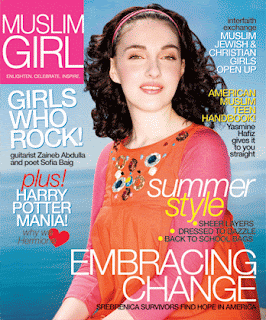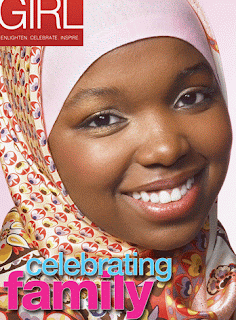If you look at the Muslim Girls website, it features the current month’s cover, as well as past covers. The covers all look like this: a happy, smiling young lady in modest dress.
The difference among the covers? Some of them feature a girl with a headscarf, and some don’t. Now, looking on the website at the features within the magazine, it appears that there is an equal distribution of women with and without headscarves, and an equal distribution of ethnicities in the models. Which makes me genuinely happy! And while the magazine still uses thinner models, I’m happy to take what I can get for now.
Despite having different publishers, today’s Muslim Girl subscribers might be tomorrow’s Azizah subscribers. But Azizah has a strict “no hejab = no cover photo” policy. It’s not stated on the website, but every back issue has the woman’s hair covered, even though they feature bihejabis in the magazine. Azizah’s website also doesn’t feature a single bihejabi in the website’s pictures. The magazine has an excellent record of ethnic diversity, but Azizah seems to think the only real Muslim is one who covers her hair. This is exclusionary and patronizing to Muslim women who do not cover their hair for whatever reason, and Muslim Girl seems to be avoiding this skillfully.
website’s pictures. The magazine has an excellent record of ethnic diversity, but Azizah seems to think the only real Muslim is one who covers her hair. This is exclusionary and patronizing to Muslim women who do not cover their hair for whatever reason, and Muslim Girl seems to be avoiding this skillfully.
Muslim Girl looks perfect on the surface: their features promote different types of modesty, ethnic diversity, and awareness of international events and local issues of interest to Muslims. At a glance, Muslim Girl seems to be touting a different, more inclusive agenda that Azizah. Let’s hope that when Muslim Girl grows up, she brings her inclusive politics with her.

